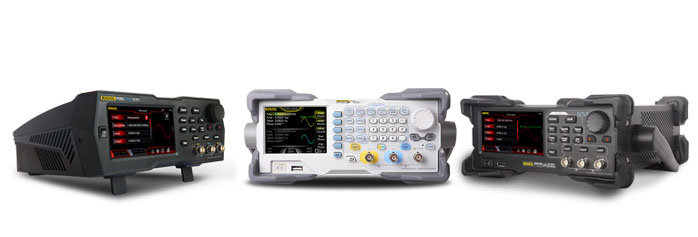

What does a function generator do?
Let’s start off by explaining what a function generator actually does. This is a piece of electronic test software or equipment that is used for the purpose of generating various kinds of electrical waveforms over a broad range of frequencies.
Some of the most common waveforms created by a function generator are sawtooth shapes, triangular wave, square wave, and sine wave. These waveforms can either be a single-shot, which requires an external or internal trigger source, or they can be repetitive.
Not only do function generators create sine waves, but they can create other repetitive waveforms, like pulses, square waves, triangular waveforms, and sawtooth. An additional feature that you will find on a lot of the different function generators is the ability for a DC offset to be added.
Despite the fact that function generators will cover both RF and audio frequencies, they do not typically suit applications that require stable or low distortion frequency signals. Other signal generators are more appropriate when these traits are needed.
Function generators play a critical role when it comes to developing, testing, and repairing electronic equipment. For instance, they can be used to introduce an error signal into a control loop or as a signal source to test amplifiers.
Function generators tend to be used mainly for working with analogue circuits. Some of the common users and uses for function generators are as follows:
• Electronic hobbyists
• Response and stimulus testing
• In-circuit signal injection
• Frequency response characterisation
• Electrical equipment and electronic repair
• Educational institutions
• Research and development
A simple function generator will typically create a triangular waveform whose frequency you can smoothly control. This triangular wave is utilised as the basis for all of the other outputs. The generation of the triangular wave occurs by charging and discharging a capacitor from a continual current source on a repetitive basis. This creates a voltage ramp that is linearly ascending and descending.
A comparator is used to reverse the charging or discharging when the output voltage gets to the lower or upper limits, and this then creates the linear triangle wave. Through varying the capacitor size and the current, various frequencies can be attained.
You can produce sawtooth waves by slowly charging the capacitor with a low current, yet utilising a diode over the existing source for quick discharge. The polarity of the resulting sawtooth will change due to the polarity of the diode, i.e. quick rise and slow fall or quick fall and slow rise.
Can a function generator be used as a power supply?
A standard DC power supply is going to provide you with a variable voltage source for DC circuits. To adjust the output voltage, you simply need to turn the knob. In a similar manner, a function generator can be an AC power supply for AC circuits. With a function generator, a variable voltage source is provided, but it can also vary the frequency, which is measured in Hertz, or the cycles per second.
A lot of the function generators that are available for sale today can alter the shape of the alternating voltage signal. The sine wave is the most common shape. However, you may also find that there are buttons that will yield other waveforms.
What is the difference between function generator and signal generator?
As there are a number of different generators that can be used when it comes to electrical testing, it can be a little bit confusing, so we will explain the difference between a signal generator and a function generator.
A signal generator will make sinusoidal waveforms available at their outputs with a settable amplitude or frequency. Should there be two channels, outputs can also be made so that they vary in phase.
There can be the possibility of adding the option for the signal to be modulated with a second lower frequency, which can be made periodic, like an audio tone or non-periodic, such as the human voice.
In addition to this, the signal can have a burst inserted, such as the colour burst within television transmission, or it can sweep between two specified frequencies in a Rigol oscilloscope demo board. Swept signals are ideal for examining circuits whose properties differ with frequency, such as tuned circuits and filters.
While they do not all operate in the same manner, a lot of the signal generators are constructed around the frequency synthesizer, which creates sine waves at specific frequencies, which is accurate to a 10 μ/sec resolution. The device is centred on an oscillator made from quartz-crystal, GPS-device oscillator, or rubidium frequency standard.
So, now that you know what a signal generator is, let’s take a look at where function generators differ. Function generators go further than signal generators do, enabling the generation of periodic standard functions such as noise, dc, ramp up and down, triangle, square, and sine.
When we talk about arbitrary function generators, often shortened to AFGs, we are referring to the function generators that can create a user-defined, periodic waveform.
You also have arbitrary waveform generators, which are not to be confused with arbitrary function generators. The former is a bit more complicated, with added features. With an AFG, you can only create a custom periodic waveform, whereas an AWG can generate a user-defined waveform of any size.
How do you set up a function generator?
The typical specifications for a general-purpose function generator are as follows:
• Produces pulse output, sawtooth, triangular, square, and sine.
• Output amplitude up to 10 V peak-to-peak.
• Support for phase modulation, frequency modulation, or amplitude modulation.
• Some function generators are able to be phase-locked to an external signal source, which could be another function generator or a frequency reference.
• Frequency stability of 500 ppm for a digital generator or 0.1 per cent per hour for analogue generators.
• It can generate a broad range of frequencies.
• An output impedance of 50 Ω.
• Some function generators will supply a DC offset voltage.
• You can modify the amplitude, typically by a calibrated attenuator with continuous adjustment for every decade step.
Of course, there are differences with every function generator, but this should help you to get an understanding of what to expect.
If you want to use a function generator to test the behaviour of a circuit, there are some steps that you should follow. Let’s take a look at them so you can get a better understanding:
1. Power on the generator and choose the desired output signal, i.e. triangle wave, sine wave, and square wave.
2. The output leads should now be connected to an oscilloscope so that the output signal is visualized.
3. Use the frequency and amplitude controls to set the parameters.
4. The function generator’s output leads need to be attached to the input of the circuit you want to test.
5. The output of your circuit needs to be attached to an oscilloscope or meter so that the resulting change in signal is visualised.
If the output voltage is not correct, you may be wondering what to do. A lot of the function generators that are available today have been designed with a 50 Ω output impedance. The reason for this is because the common RF connection cables have 50 ohms in terms of characteristic impedances. Some generators will have an output impedance that is adjustable. However, the amplitude of these generators is correct when the output of the generator is terminated in a load that is equal to the output impedance. Therefore, if the output is terminated with the correct feed-through terminator, you will measure the exact voltage as the setting of the generator.
Should you operate a 50 Ω impedance generator into a high impedance input, for example, an oscilloscope with a 1 MΩ input impedance, you are going to see roughly twice the state generator output.
Putting a non-reactive resistor, for example, a carbon film resistor, across the output terminals of the suspected output impedance of the generator is a quick test you can do. You should check the output voltage across the termination resistor, but make sure you are careful to not exceed the power rating of the resistor.
Final words on using a function generator
So there you have it: an insight into function generators. This is one of the most vital and versatile pieces of testing equipment when it comes to electrical products. We hope that this guide has helped you to get a better understanding regarding how it functions, and also how it differs when compared with the other generators that are on the market today.









































